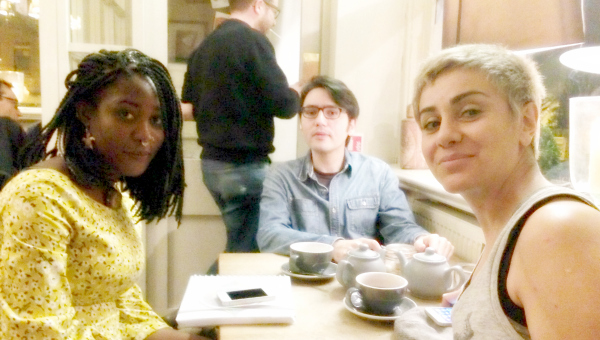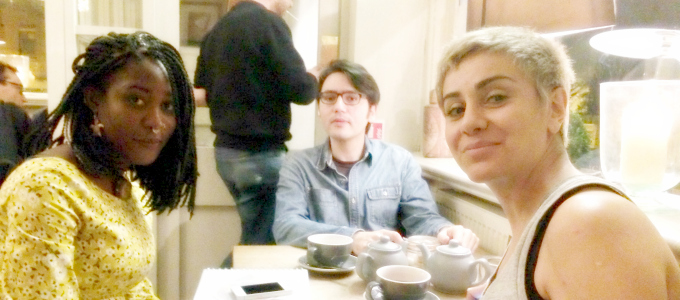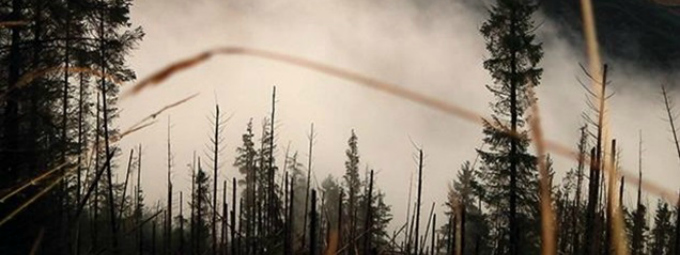Reel Women and Screen St Ives are proud to present three films by internationally renowned Iranian director Mania Akbari, to be screened at the Arts Picturehouse in Cambridge on 25-27 April. We are enormously pleased to announce that Mania will attend all three films and take part in post screening Q&As.
Mania Akbari came to prominence as the lead actor in Abbas Kiarostami’s masterpiece TEN. She subsequently became a highly regarded filmmaker, artist, and writer in her own right. Her films have screened at festivals around the world and have received numerous awards. She had a major retrospective of her films at the BFI Southbank in 2013, and the upcoming screenings at the Cambridge Arts Picturehouse will offer a rare chance to see some of Mania’s films on the big screen – and to meet her in person.
Akbari was recently interviewed on “Bums On Seats“, and you can read a transcript below.
With thanks to facilitator Toby Miller; interviewer Day Moibi; translator Ehsan Khoshbakht and transcriber Mike O’Brien.
Day Moibi: To begin, I want to ask you about your earliest creative experience. What was the moment which convinced you that this was something you had to do?
Mania Akbari: I think the first time I experienced a kind of creative moment in my life was when I was still in school. I wrote this story and when it became quite successful, that was the first time I realised how much I enjoyed it, in a very naive, innocent way, and how much I wanted to continue telling stories. It was a very exciting experience because it created an interaction with me and my readers, my audience, because they were coming to me asking certain questions, like why is this part like that, who’s this character. There was lots of sympathy, and I was very happy about that and I was enjoying that. To me it was even better than getting an A in maths.
The reason I’m sitting here with you is probably because of the pleasure I had in that creative moment, when I decided, OK, this is what I want to do. That’s why we’re here now.
DM: Does that energy, that fire which started within you, does it continue growing?
MA: I don’t look at it like that because I don’t see a process. I think it’s something you’re born with. So if you discover it in yourself you can start exploiting that throughout your creative life. So it’s just a matter of self-discovery and then putting it into practice. There are other more important factors involved too, like knowledge and experience; it’s like a Persian rug – everything is interwoven. For me, it’s impossible to say, once I start something, when it’s going to end, I just know that I’m in the process of creating.
DM: When you’re creating, is it a process of self revelation, an internal process for you and the viewer?
MA: I think every artist is a very fragile, insecure person and being creative is the only solution, the only way out that the artist has. They gradually find their medium, through which they can express themselves. The art of the artist is a metaphor of themselves: the art questions the artist. I can’t explain why I picked cinema as my tool, my medium, for expressing myself. I always wanted to be a painter – I started as a painter – and I still believe that painting is the mother of all the arts. But somehow it was painting that rejected me: painting is associated with solitude, loneliness and being contemplative and meditating and my energy and my passion was beyond what I could express in painting. So when I started making my first films my notion was to create a different kind of painting, in which the images are drawn by dialogues and conversations between characters. I tell the stories and ask my viewer to do the painting. I substitute the painting canvass with my spectator, in other words, the spectator becomes my painting canvass.
What we desperately need is the voice of women, of mothers, in art.
DM: There are not many women making films; what do you think would be different if there was more equality in the film industry?
MA: When I study the history of art I come across many female artists who are under-appreciated or forgotten. There are many possible reasons for this. The first could be the result of different religions and traditions that exist in societies. Another possibility is that women are those who give birth, a power of sorts, and men wanted to keep the power of art to themselves, instead of equally sharing it. Women’s ability to give birth must have been very scary to men back in history. One can argue that men thought of women as already creative in their ability to give birth.
The psychology attributed to these two different genders could have been a factor for having less creative female artists. What we desperately need is the voice of women, of mothers, in art.
DM: How has your exile from Iran changed your creative process?
MA: I think we all live in a kind of exile after coming out of the womb. We are constantly searching for that sheltered, secure place we came from before we were born. I have always felt that I wasn’t fully part of our society; even back in Iran I felt as if I was living in exile. I was like a gypsy, I wasn’t looking for home, I was just looking for ways in which I could be freer in expressing myself.
I noticed a giant leap forward when I started my film correspondences with Mark Cousins for LIFE MAY BE. When I was watched the film, I realised my voice has changed. I was always in my own films, acting in my own films, directing them, now I realise that I hear different things, and am curious to know what has changed in me. And then I realise that this is a voice which has found freedom of expression, but is sadder, is lonelier. It’s a voice which is carrying memories and dreams. These memories are not easy ones – memories of war; memories of war between a man and a woman; war between dead and alive; the conflict between my body and society; between my body and religion.
DM: How was that process of working with Mark Cousins? Did you find the exchange of video letters limiting or liberating in terms of what you could do?
MA: Changing one’s habits is very painful, and getting used to it is very painful, because it means you have to forget what it is you are used to, push them into the past, and move to a new stage in life. It is like the tree I have in front of my kitchen window, which is now blossoming. Whenever I look at that tree I know that this blossom is part of something painful, because it’s breaking out of something. I was in a kind of creative pain when I was working with Mark, and LIFE MAY BE was like that blossom on the tree. It was like giving birth. When I was pregnant I was thinking, OK, when I give birth to my son it’s going to be very painful, but then you hold your child in your arms. Making LIFE MAY BE was like giving birth; it was painful but we were ready to embrace the final film.
It’s a very masochistic experience for the artist to create, because after this pain of giving birth you are looking for the next pain, to repeat that experience. It’s a kind of madness. We are afraid of talking about being mad or going mad, but I’m very interested in the relationship of madness and creativity and looking at this in my work.
DM: Is this what your next project with Douglas White will be exploring?
MA: Yes. How the artist uses aesthetics and beauty, like a leash, to control the madness and be creative.
It’s a very masochistic experience for the artist to create…
DM: What inspired this project after LIFE MAY BE?
MA: After LIFE MAY BE I discovered the world of objects, statues, and how they can speak to me and revive my memories about Iran. Whenever I look at an object, like this tea pot on the table here, I instantly start comparing that object with my experience of that it back in Iran. I make an instant comparison. I started looking for other artists from around the world who have come to London and tried to use objects for telling us something about their culture or background. One of the older exhibitions by Anish Kapoor was very important for me because Kapoor too came to this country. What intrigued me was how he presented very colourful powders from India, used for rituals and ceremonies, in this exhibition, and the minimalist way that he organised batches of colour here and there. I was looking for these kinds of artists, who were creating something connected with their culture in a new place with a new language. After LIFE MAY BE, the first film letter I sent was to Kapoor.
In the meantime I was introduced to Douglas White and I went to his studio and made a profound discovery: it was very moving to see that his sculptures reminded me of my own experience of Eastern art. Interestingly, he had never been to Iran or that region. When I saw the work I thought he must have lived in Iran or in one of the neighbouring countries. I don’t mean that when you look at his work you can see something specifically Iranian, but his various projects revive the memory of Iran in different ways.
The spirituality of Iranian art is very important and also the violence which is entangled with beauty. For instance, in my first film letter to Douglas White, I discuss what Douglas has done with very old burnt car tyres; he has turned them into beautiful palm trees which resemble the palm trees from southern Iran. Amazingly, in many of the trees which he has installed around the world, birds come and make nests because they treat them as real trees. For me, this has a symbolic significance because when I was a child back in Iran the war with Iraq was happening in the south and many palm trees were burnt. So for me the image of burnt trees was an image of war, and also of a lost generation, a wasted generation, of my generation during the war. And that was the beginning of my conversation and dialogue with Douglas White, which is still continuing.
I discovered that you don’t have to be from the East to understand Eastern art. You just have to understand the experience of coming from the East or being in the East to create something resembling Eastern arts.
I think our government are afraid of the arts because they have seen that the arts can bring change.
DM: Gender and sexuality is an important theme in your work, so how have your recent collaborations influenced your opinions?
MA: I don’t think they are concrete answers to the question of what it means to be a man or a woman. I think we are both, have both genders. I think it’s a never ending conflict, or question, about gender, between men and women. It will never end.
I had an uncle who was a mullah. One day I spent some time with him, we were talking about Islam, and I realised the main question, the main recurring theme in Islam according to what my uncle was saying, was the body and gender. All the rules and conventions in the books, in Islamic texts, how to do wazoo for praying, how to have sex with your partner, they are all about gender, about the body. Many sins are defined according to matters relating to gender, body, and sexuality. When I was in Israel I had this conversation with a religious person, and I realised the central theme in Judaism too, is the body and sex. He explained to me that there were people who have had five children and never seen the full naked body of their partner. The body is an important part of my artwork.
DM: In terms of freedom, what do you think are the cultural norms and boundaries that limit what can be discussed in English cinema?
MA: I think there are boundaries here too, but not as clearly defined as in Iran. There, if you wanted to make a film freely, for instance getting funds from the government, you had to abide by certain rules and you had to follow the dominant ideology. I didn’t belong to that group, I was an underground filmmaker making very small films which didn’t need a big budget. I know filmmakers here who have been faced with restrictions made by funders.
Cinema is an artform with a huge audience so it’s only natural that the government are sensitive towards it and what it chooses to represent. I think our government are afraid of the arts because they have seen that the arts can bring change. Even the most liberal countries have boundaries and borders set for film, and which can reveal itself in funding policies for films and things like that. It is a kind of censorship.
DM: Degas, the sculptor and painter, said that ‘Art is not what you see, but what you make others see’”. What do you think of this?
MA: This is one of my main concerns too. The moments in a film that the mainstream cinema tends to throw away are the moments I think should be kept, are the moments I’m more interested in. For instance a scene with a woman in front of the mirror playing with a spot for some minutes is not shown, but in my films I show this. It’s like breaking some rules or values and creating new beauties. Who said this act is ugly? No, it’s not. And these simple facts of life, we censor these ourselves, we repress them; after a while we don’t see them anymore. I want to show these moments. I want them to be remembered, not forgotten.
Every art object and moment has a story of its own. And there are hidden, secret mysteries as well. And from the point of view of psychology we reject these objects and moments because they remind you of the things we don’t want to remember.
The screenings of Mania Akbari’s films at the Arts Picturehouse in Cambridge will take place on:-
Monday 25th April, 6:00 pm: LIFE MAY BE (co-directed with Mark Cousins)
Tuesday 26th April, 6:15 pm: 20 FINGERS
Wednesday 27th April, 6:15 pm: ONE.TWO.ONE
In addition to the screenings, two associated day courses will be taking place at the Arts Picturehouse, with specially reduced ticket prices. These are:-
Saturday 23th April: Dreams Of Our Lives: Feminist Film Now
Saturday 30th April: Contemporary Iranian Cinema
This season is supported by the BFI Film Audience Network and the Arts Picturehouse, Cambridge.
httpvh://www.youtube.com/watch?v=6K2peyQTQ6c



